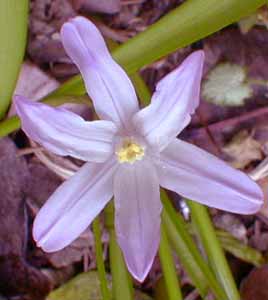
'Pink Giant'
Glory-of-the-Snow
"A lawn, close-clipped & pale,
Studded with flowers."
-Ida O'Neil,
fl.1920s
fl.1920s
Chionodoxa forbesii 'Pink Giant' would seem to be a misnomer for this 1947 cultivar, since its pale lavender-pink blooms are actually smaller than those on the natural blue Glory-of-the-Snow.
It probably got designated "Giant" not for its tiny size, but because of the old species name C. gigantea, which it was called before it was called C. luciliae, which is now supplanted by C. forbesii though many bulb packagers still list them by the outdated name C. luciliae.
In an article about Glory-of-the-Snow, the commentator said it was one of the least appreciated & underrated of the minor bulbs. One reason it is underappreciated, I would suggest, is because of the overly broad recommendation that they be planted in partial shade.
Here on Puget Sound, at least, they do vastly better with full morning sun, or a long day of dappled sunlight. But we believed the recommendation that they be given shade, resulting in such sub-par performance that if I hadn't also planted some of the blue ones in a sunny spot, & seen them perform beautifully, I would just have assumed their lack of popularity was due to their crappy appearance.
They're supposed to do well in full sun or partial shade, in zones three through eight. Since we're in USDA Zone 8, which is the warmest end of their tolerances, I had assumed these bulbs would be particularly ammenable to part shade, but this turned out to be a bad judgement.
Sunlight on the Northwest coast is mild compared to inland or further south. So for two bloom seasons running, our shaded 'Pink Giant' Glory-of-the-Snow produced foliage that was thin, gangly, untidy, & of mediocre appearance, but worse, the stems would not hold the flowers up well enough, so that as soon as the buds opened, often the flowers would tumble petals-down onto the soil.
Striving to get better results, we last year (autumn 2003) planted another batch of Chionodoxa bulbs, the newer ones placed in a greater amount of sunlight, hoping they wouldn't be so floppy. The new drift was supposed to be a mixed selection of 'Pink Giant,' the natural blue, & the pure white 'Alba,' but for some reason only blue ones sprang up the following spring. They bloomed a bit later than the shaded patches, but they were vastly more pleasing & floriferous. Now that I know for sure they do need half-sun to look their best, I plan to plant more of them in appropriate locations, especially at lawn-margins so that they will help blur where the gardens end & sod begins.
As they bloom mid-March & into April, & a lawn can't be mowed until after post-bloom foliage of crocuses & glory-of-the-snow are turning yellow five weeks later, trying to get bulbs to naturalize in lawns means not doing the first spring mowing until late May, or when the grass is a foot tall. One reason people often fail to get such bulbs established in lawns is because they mow too soon in spring, & with the leaves prematurely mowed along with the lawn, the bulbs cannot recharge & produce offsets.